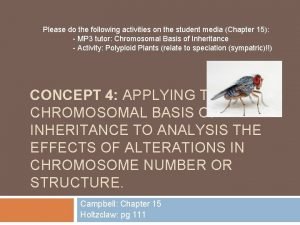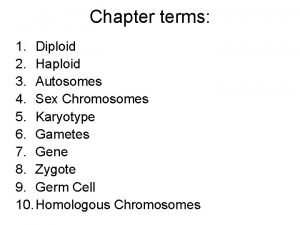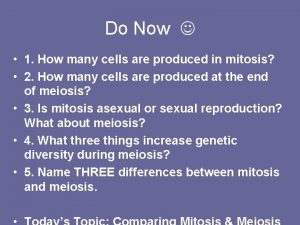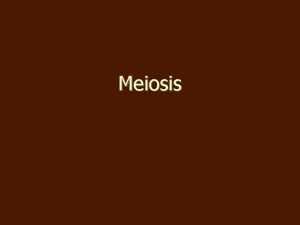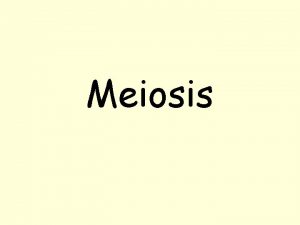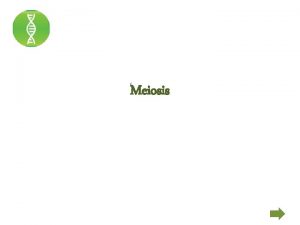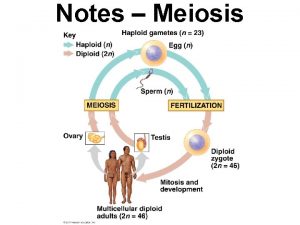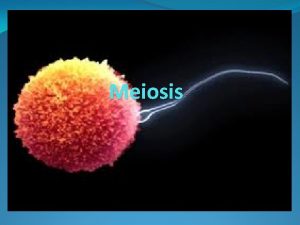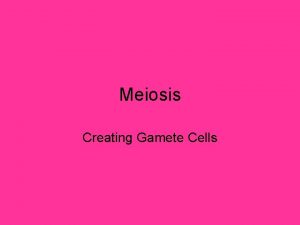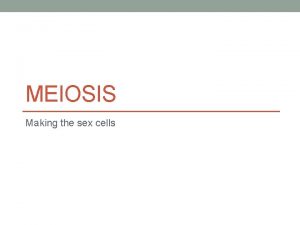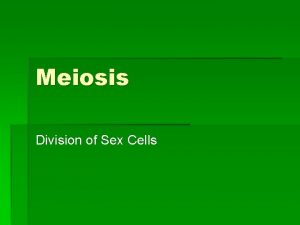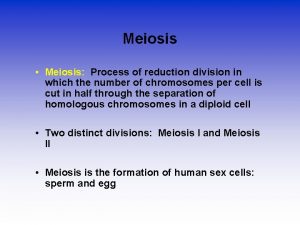3 1 Meiosis The process which produces cells
















- Slides: 16

3. 1 Meiosis The process which produces cells for: • Sexual reproduction called gametes, with • 1/2 the no. of chromosomes as the parent http: //www. youtube. com/watch? v=rq. PMp 0 U 0 HOA

Multicellular organisms that reproduce sexually have two types of cells: 1. Somatic Cells 2. Gametes

Somatic Cells 1. Reproduce by cell division (mitosis) 2. Make up the vast majority of an organisms cells 3. In humans, somatic cells have 23 pairs of chromosomes = 46 chromosomes in total

Gametes 1. Have half the chromosomes of the parent cell 2. Male gametes are called sperm 3. Female gametes are called eggs (ova or ovum)

Scrambled Somatic Cells vs Gametes Somatic (? ) Male Cells are called sperm Gametes (? ) Reproduce by cell division (mitosis) Make up the vast majority of an In humans, somatic cells have organisms cells 23 pairs of chromosomes = 46 chromosomes in total Have half the chromosomes of the parent cell Female Cells are called eggs (ova or ovum)

Meiosis: the process which produces half the number of chromosomes in an organism’s somatic cells thereby producing gametes Figure 2: Fruit Fly (p. 74) • Somatic cells have 8 chromosomes • Gametes contain 4 chromosomes (haploid = n) 4 (diploid = 2 n) 4 8 4 4

Homologous Chromosomes: (p. 75) • The genes on one of the chromosome pairs corresponds to the genes on the other chromosome pair • They are coded for the same characteristic (ie. Eye colour)

Homologous Chromosomes: (p. 75) • Pairs of corresponding chromosomes (in diploid somatic cells = 2 n) Have corresponding genes for eye colour from each parent at the same locus

Stages of Meiosis: Meiosis I: see Figure 4 a & 4 b • Interphase: chromosomes replicate to form joined sister chromatids • Prophase: chromosomes shorten and thicken (become visible with light microscope) • Metaphase: homologous chromosomes joined to sister chromatids pair up along the equator • Anaphase: pairs of homologous chromosomes separate and move to opposite poles along with sister chromatids. (sister chromatids do not separate)

Meoisis I: Anaphase: pairs of homologous chromosomes separate and move to opposite poles along with sister chromatids. (sister chromatids do not separate) – Two daughter cells each only have one of the homologous chromosomes with its sister chromatid still attached (see Figure 4)

Meiosis II: see Figure 4 c • Sister chromatids in two daughter cells line up at the equator • Each chromatid is pulled to the opposite pole • Nuclear membranes reform • Cytokinesis occurs resulting in 4 haploid daughter cells called gametes.

Stages of Meiosis II:

Comparison of Mitosis and Meiosis Table 1 (p. 77) Stage Parent Cell Sister Chromosome No. Chromatids Number of Daughter Cells Number of Chromosomes Mitosis 2 n Separate during anaphase 2 2 n Meiosis 2 n Stay together in meiosis I but separate in meiosis II 4 n

Meiosis II

Assignment 1. 2. 3. 4. 5. Make a model of Meiosis I and II Label all the parts Use Figure 4 on page 76 for the stages Work with one partner Use plastacine or paper to create your model

http: //www. youtube. com/watch? v=35 nc. Sr. JOw. ME
 Identify the structure
Identify the structure Which organism
Which organism Produces diploid cells
Produces diploid cells Where is semen stored
Where is semen stored A spermatocyte produces the following four sperm cells
A spermatocyte produces the following four sperm cells Meiosis i vs meiosis ii
Meiosis i vs meiosis ii Meiosis 1
Meiosis 1 Crossing over occurs during
Crossing over occurs during Differences between mitosis and meiosis
Differences between mitosis and meiosis Section quick check chapter 10 section 1 meiosis answer key
Section quick check chapter 10 section 1 meiosis answer key Chapter 10 section 1: meiosis
Chapter 10 section 1: meiosis Telophase 1
Telophase 1 Are diploid cells produced in meiosis
Are diploid cells produced in meiosis What is a haploid cell
What is a haploid cell How many cells are produced in meiosis? *
How many cells are produced in meiosis? * Meiosis
Meiosis Http://www.cellsalive.com/meiosis.htm
Http://www.cellsalive.com/meiosis.htm




